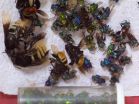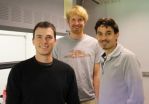(Press-News.org) Smithsonian scientists have discovered two new, closely related bee species: one from Coiba Island in Panama and another from northern Colombia. Both descended from of a group of stingless bees that originated in the Amazon and moved into Central America, the ancestors of Mayan honeybees. The presence of one of these new species on Coiba and Rancheria Islands, and its absence from the nearby mainland, is a mystery that will ultimately shed light on Panama's history and abundant biodiversity.
At almost 200 square miles, Coiba Island is the largest offshore island along the Pacific coast of Latin America. Rancheria Island is a much smaller neighbor. The species name, insularis, of the new bee from Coiba, Melipona insularis, means "island." This is the first species in its group to be found on islands near the mainland.
"These forest bees have a small range over which they can establish new nests and colonies," says David Roubik, staff scientist at the Smithsonian Tropical Research Institute. "They can't establish a new nest across more than a short stretch of open water because workers from the original nest have to build and supply the new nest before the new queen moves in."
Either several entire tree-cavity nests arrived on Coiba and Rancheria in floating mats of vegetation or a land connection existed between the island and the mainland before the bees disappeared from the mainland.
Sea level has risen and fallen dramatically in the past. During ice ages, when much of the Earth's water is locked up in polar caps and glaciers, sea level drops in Panama. The sea floor between Coiba and the mainland, and between Coiba and neighboring Rancheria Island where the bee was also found, is never more than about 300 feet below the surface. Five other stingless bee species on Coiba are widespread on the mainland and on many little islands that were connected to the mainland during glaciations. Those bees are relative newcomers that may have arrived during past drops in sea level when the islands were reconnected to the mainland.
Roubik thinks the ancestors of Melipona (Melikerria) ambigua, the new species from Colombia, gave rise both to the new Coiba bee and the honeybees cultivated by Mayans in Mexico and Central America. Even if a drop in sea level explains how the bees got from the mainland to the island, their discovery that the bees had already established in Central America around 17 million years ago spurs an ongoing debate about the age of the connection between North and South America. Traditionally, geologists think that the Panama land bridge arose by tectonic and volcanic action to connect the two continents about 3 million years ago.
"Our studies of the genetic relationships between these bees tells us that they originated in the Amazon about 22 million years ago and that they moved north into Central America before 3 million years ago," said Roubik. "This actually agrees with new evidence that geologists working in the earthworks created by the Panama Canal expansion project are finding. We think that a land bridge may have formed as early as 12 million years ago."
Not only does the age of the continental connection remain unresolved, there are more questions, such as what happened to the bees that used to be on the mainland and are no longer there now?
Panama's wealth of biodiversity may be a direct result of the complicated geological history of the area. Only by combining geological evidence, genetic evidence and observations of how organisms behave and respond to change in natural areas like Coiba National Park, can scientists begin to understand the puzzle that is Panama.
INFORMATION:
The Smithsonian Tropical Research Institute, headquartered in Panama City, Panama, is a unit of the Smithsonian Institution. The Institute furthers the understanding of tropical nature and its importance to human welfare, trains students to conduct research in the tropics and promotes conservation by increasing public awareness of the beauty and importance of tropical ecosystems. Website: www.stri.org.
Roubik, D.W., Camargo, J.M.F. 2011. The Panama microplate, island studies and relictual species of Melipona (Melikerria) (Hymenoptera: Apidae: Meliponini). Systematic Entomology. DOI: 10.1111/j.1365-3113.2011.00587.x
2 new bee species are mysterious pieces in the Panama puzzle
2011-10-19
ELSE PRESS RELEASES FROM THIS DATE:
Penn researchers demonstrate efficacy of non-Hodgkin's lymphoma vaccine
2011-10-19
PHILADELPHIA — An experimental vaccine developed by researchers at the University of Pennsylvania's schools of Medicine and Veterinary Medicine is the first veterinary cancer vaccine of its kind that shows an increase in survival time for dogs with spontaneous non-Hodgkin's lymphoma. The work shows for the first time the feasibility and therapeutic efficacy of this alternative cell-based vaccine, which could be employed in the treatment of a number of different cancer types.
The research was conducted by Nicola Mason, assistant professor of medicine at Penn Vet; Robert ...
Congressman Fortenberry's New GI Bill Promises Veteran Entrepreneurship And Jobs Creation; Bill Authored By Service Disabled Veteran
2011-10-19
On October 13, with little fanfare, Congressman Jeff Fortenberry (NE-1) introduced the Veterans Entrepreneurial Transition (VET) Act of 2011, a landmark new GI Bill that would allow veterans to use their already budgeted educational benefits earned under existing GI Bills, to start up new small businesses.
The VET Act (H.R. 3167) is a GI Bill aimed at addressing the unacceptably high veteran unemployment rate, as well as to help quickly re-build a new generation of veteran-owned small business enterprises across America as the backbone of new job creation.
This GI ...
The political effects of existential fear
2011-10-19
Why did the approval ratings of President George W. Bush— who was perceived as indecisive before September 11, 2001—soar over 90 percent after the terrorist attacks? Because Americans were acutely aware of their own deaths. That is one lesson from the psychological literature on "mortality salience" reviewed in a new article called "The Politics of Mortal Terror." The paper, by psychologists Florette Cohen of the City University of New York's College of Staten Island and Sheldon Solomon of Skidmore College, appears in October's Current Directions in Psychological Science, ...
African-Americans more likely to donate kidney to family member
2011-10-19
WINSTON-SALEM, N.C. – Oct. 18, 2011 – Family matters, especially when it comes to African-Americans and living kidney donation. In a study conducted at Wake Forest Baptist Medical Center, researchers found that African-Americans donate almost exclusively to family members for living kidney transplants, as compared to Caucasians.
The retrospective study, published in the September/October online issue of the journal Clinical Transplantation, compared medical records of all former successful kidney donors at Wake Forest Baptist between Jan. 1, 1991, and Dec. 31, 2009. The ...
How hemp got high: Canadian scientists map the cannabis genome
2011-10-19
A team of Canadian researchers has sequenced the genome of Cannabis sativa, the plant that produces both industrial hemp and marijuana, and in the process revealed the genetic changes that led to the plant's drug-producing properties.
Jon Page is a plant biochemist and adjunct professor of biology at the University of Saskatchewan. He explains that a simple genetic switch is likely responsible for the production of THCA, or tetrahydrocannabinolic acid, the precursor of the active ingredient in marijuana.
"The transcriptome analysis showed that the THCA synthase gene, ...
More evidence that allergies may help in fighting brain tumors
2011-10-19
PROVIDENCE, R.I. [Brown University] — A study published online Oct. 18 in the Journal of the National Cancer Institute provides some new but qualified support for the idea that the immune system's response to allergies may reduce the risk of developing deadly brain tumors.
People with somewhat elevated blood levels of immunoglobulin E (IgE), antibodies that carry out the body's immune response to allergens, were significantly less likely to develop gliomas, and those who did survived somewhat longer, than those with clinically normal IgE levels, according to the study ...
VISTA finds new globular star clusters and sees right through the heart of the Milky Way
2011-10-19
The dazzling globular cluster called UKS 1 dominates the right-hand side of the first of the new infrared images from ESO's VISTA survey telescope at the Paranal Observatory in Chile. But if you can drag your gaze away, there is a surprise lurking in this very rich star field — a fainter globular cluster that was discovered in the data from one of VISTA's surveys. You will have to look closely to see the other star cluster, which is called VVV CL001: it is a small collection of stars in the left half of the image.
But VVV CL001 is just the first of VISTA's globular discoveries. ...
Casey Storage Solutions Acquires Self Storage Facility in Pawtucket RI
2011-10-19
Casey Real Estate Investment, LLC and Casey Property Management, LLC are pleased to announce the acquisition of a 72,000 square foot self storage facility located at 201 Concord Street in Pawtucket RI. The new store will operate under the brand name, Casey Storage Solutions (http://www.caseystoragesolutions.com). The property will be managed by Casey Property Management, LLC.
This acquisition brings Casey Storage Solutions' holdings to eight self storage properties consisting of over 450,000 square feet and over 3,500 self storage units. Casey Storage Solutions operates ...
Polymer characterization 'tweezers' turn Nobel theory into benchtop tool
2011-10-19
(UC Santa Barbara –) Researchers at UC Santa Barbara have developed a new and highly efficient way to characterize the structure of polymers at the nanoscale – effectively designing a routine analytical tool that could be used by industries that rely on polymer science to innovate new products, from drug delivery gels to renewable bio-materials.
Professor Omar Saleh and graduate student Andrew Dittmore of the UCSB Materials department have successfully measured the structure and other critical parameters of a long, string-like polymer molecule – polyethylene glycol, or ...
Can breastfeeding reduce pain in preterm infants?
2011-10-19
Philadelphia, PA, October 19, 2011 – Poorly managed pain in the neonatal intensive care unit has serious short- and long-term consequences, causing physiological and behavioral instability in preterm infants and long-term changes in their pain sensitivity, stress arousal systems, and developing brains. In a study published in the November issue of PAIN®, researchers report that breastfeeding during minor procedures mitigated pain in preterm neonates with mature breastfeeding behaviors.
Currently, pain associated with minor procedures such as pricking for blood tests ...


